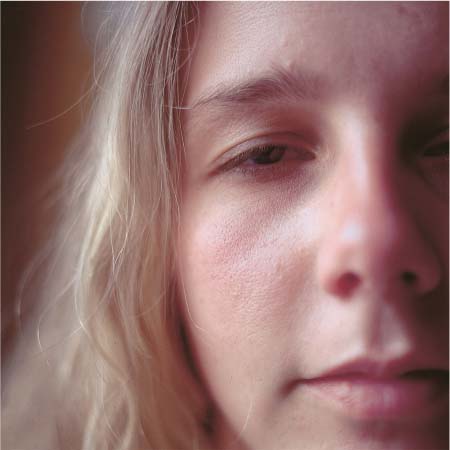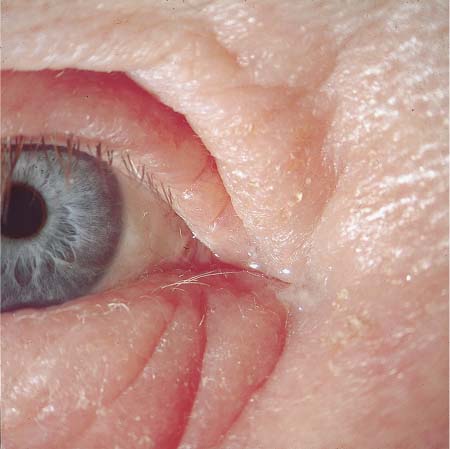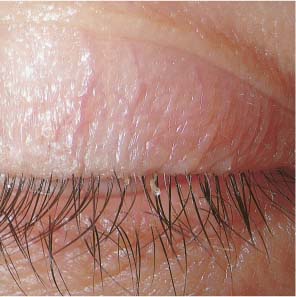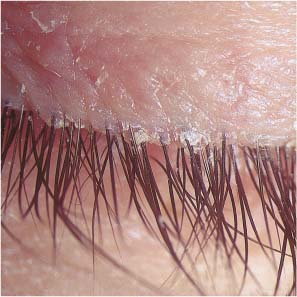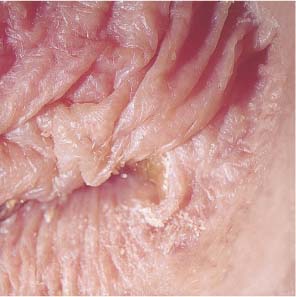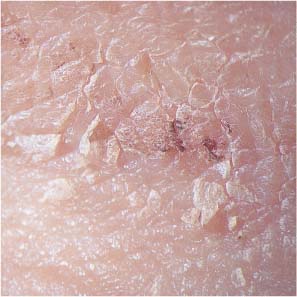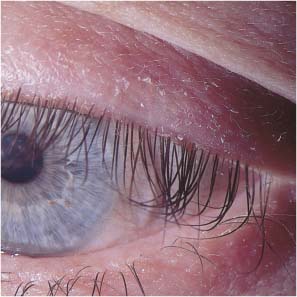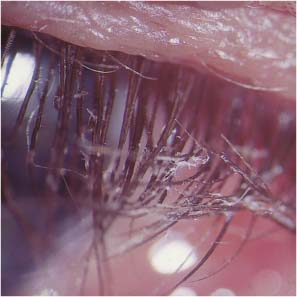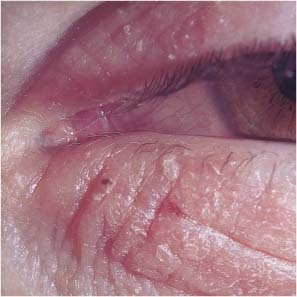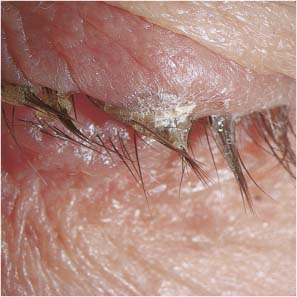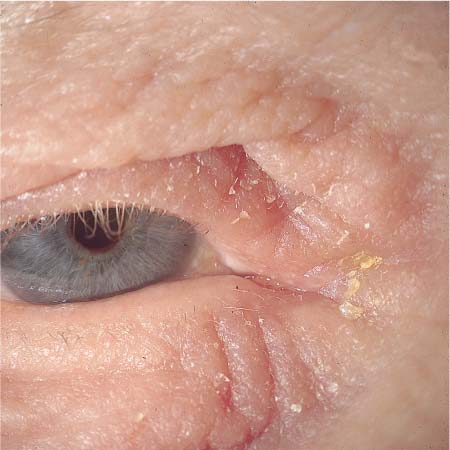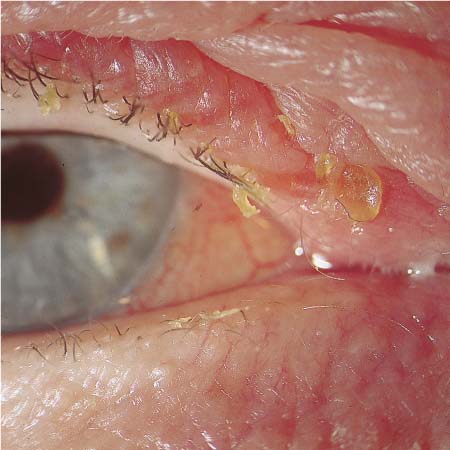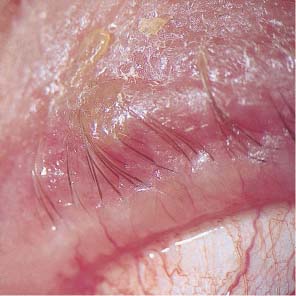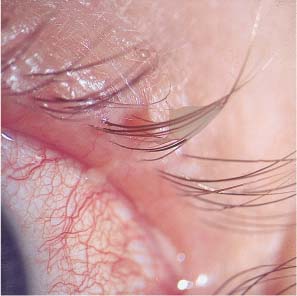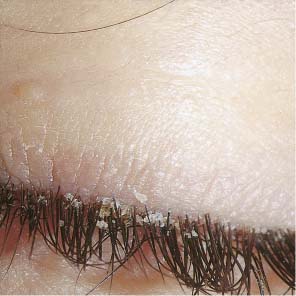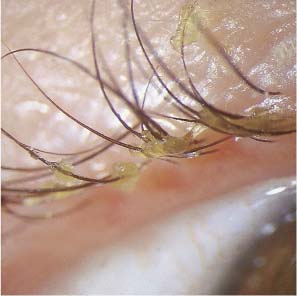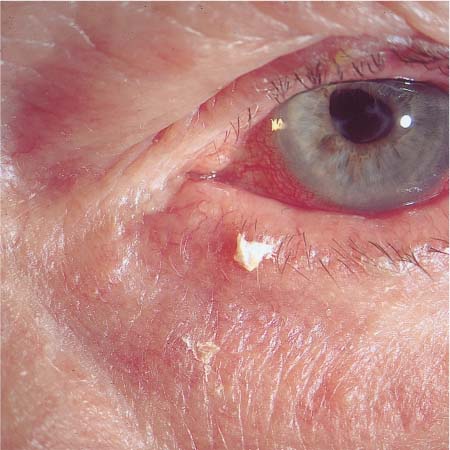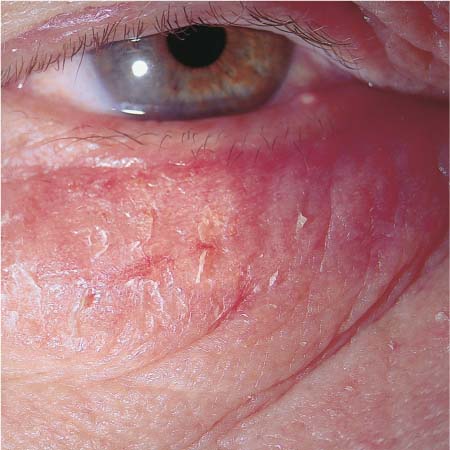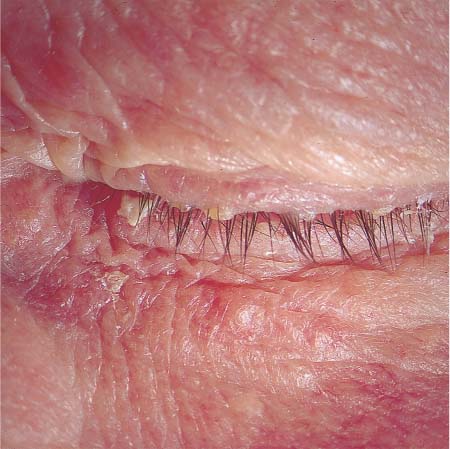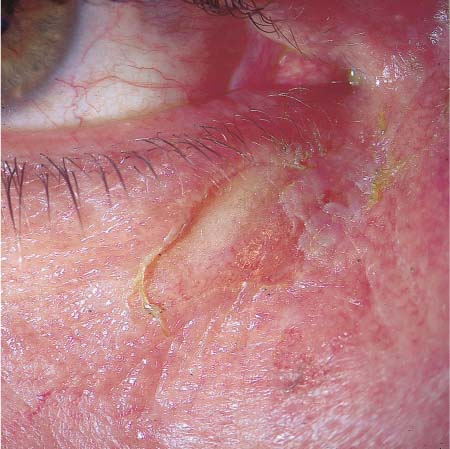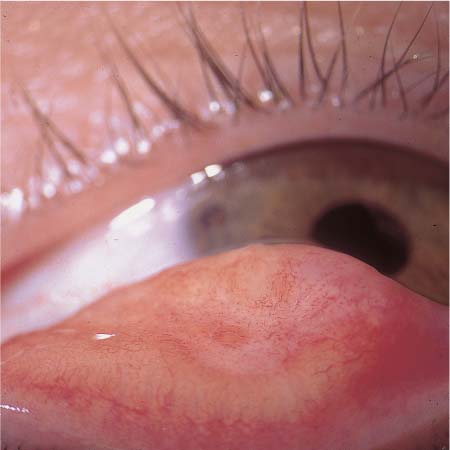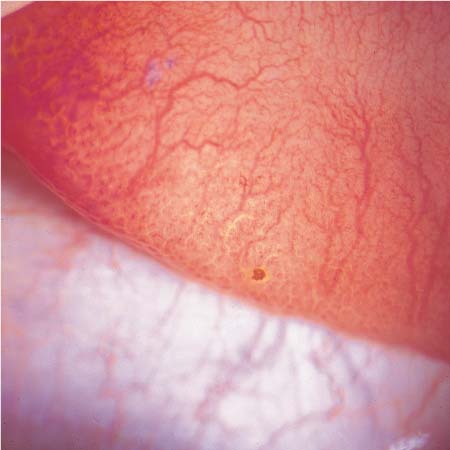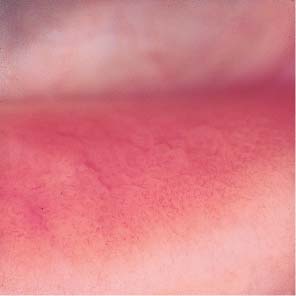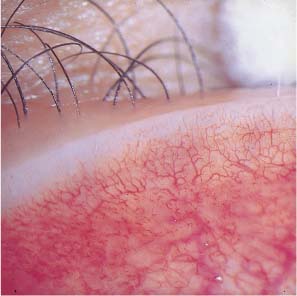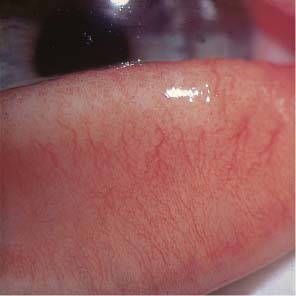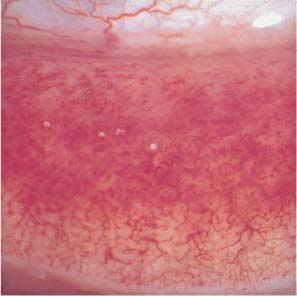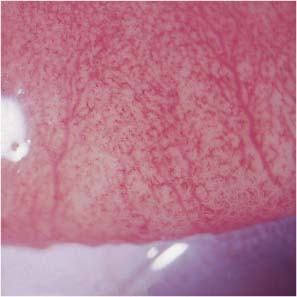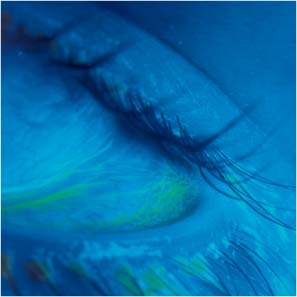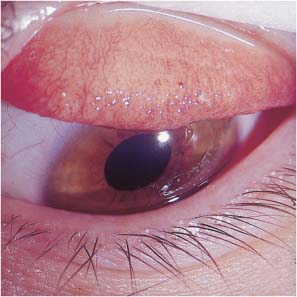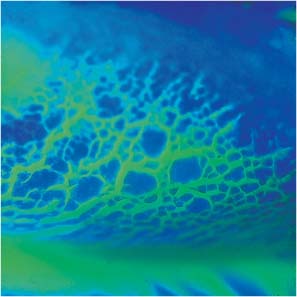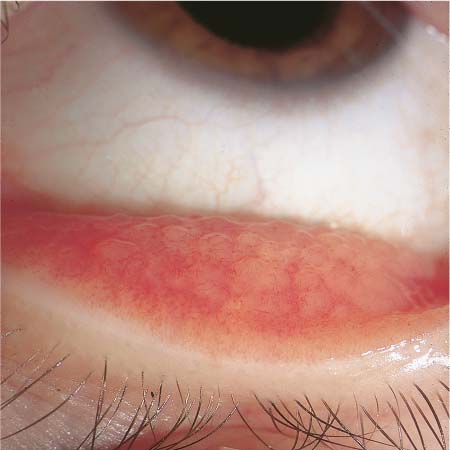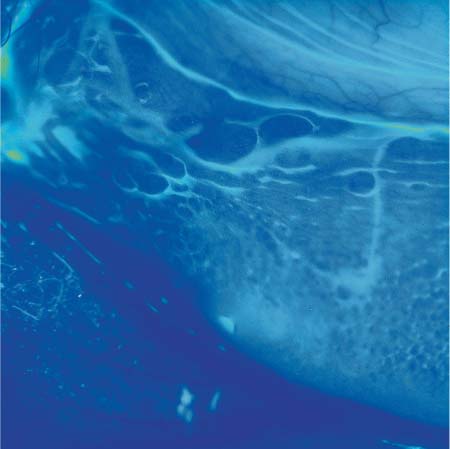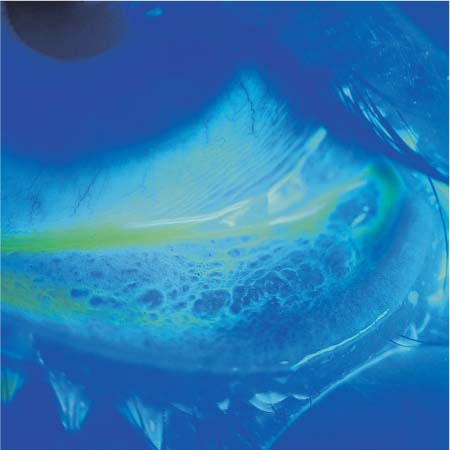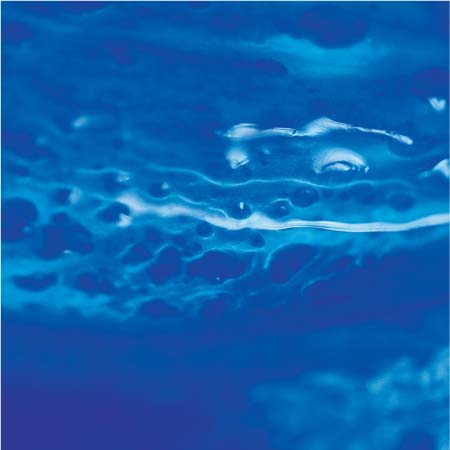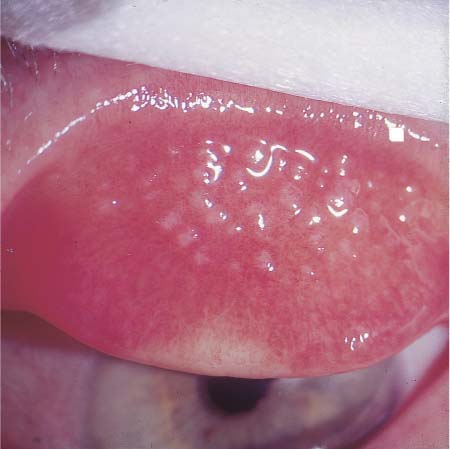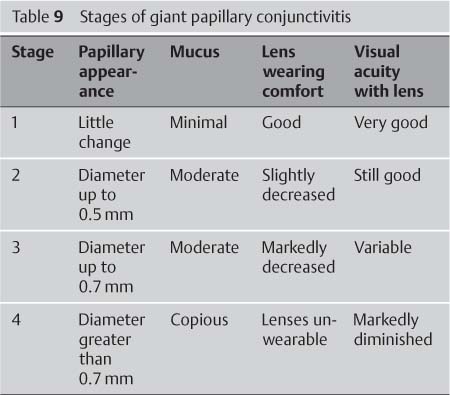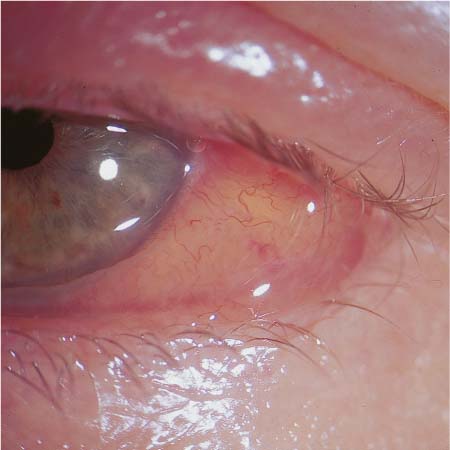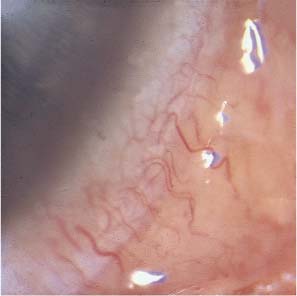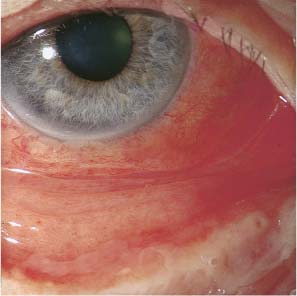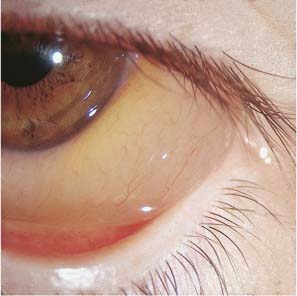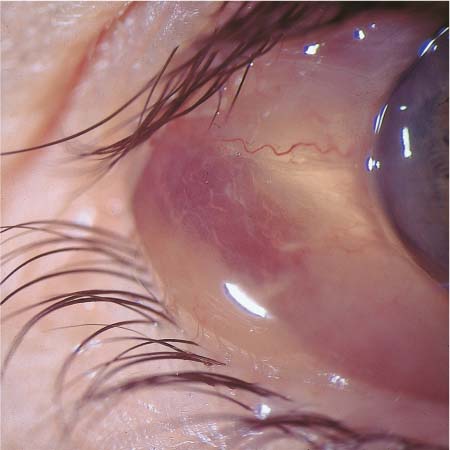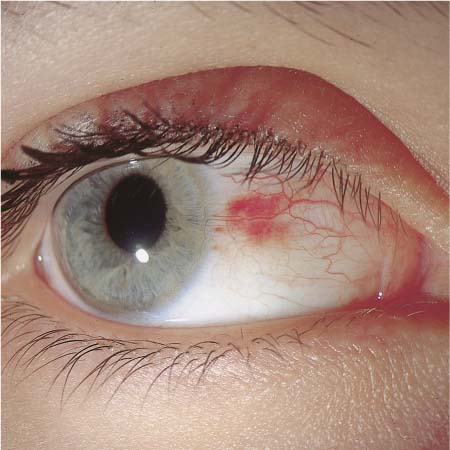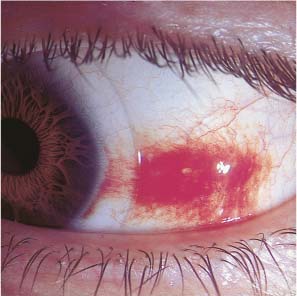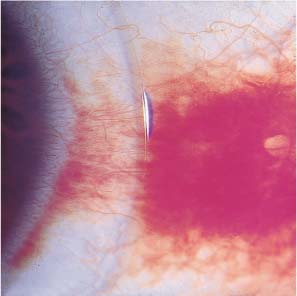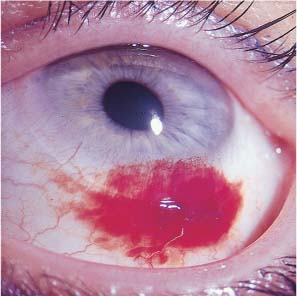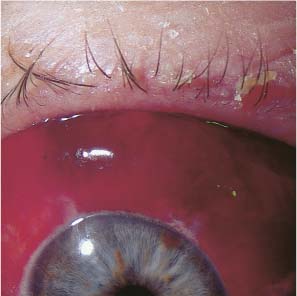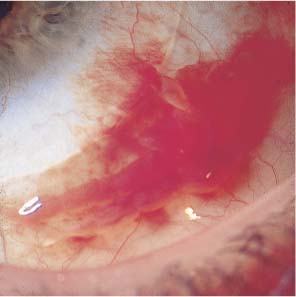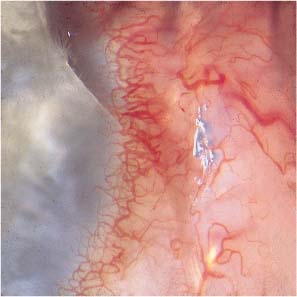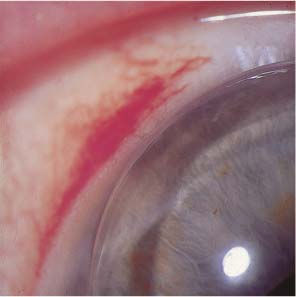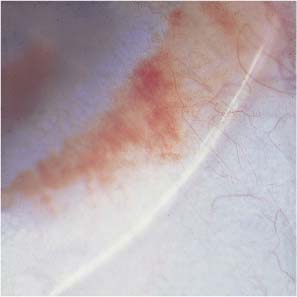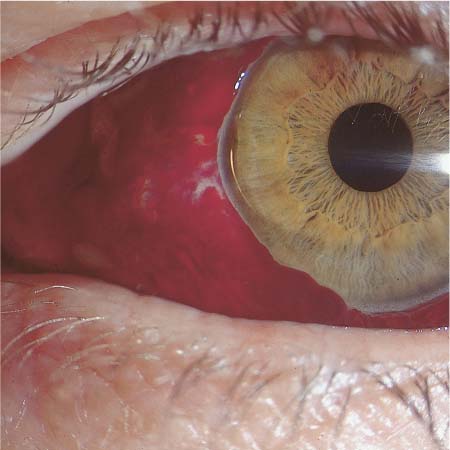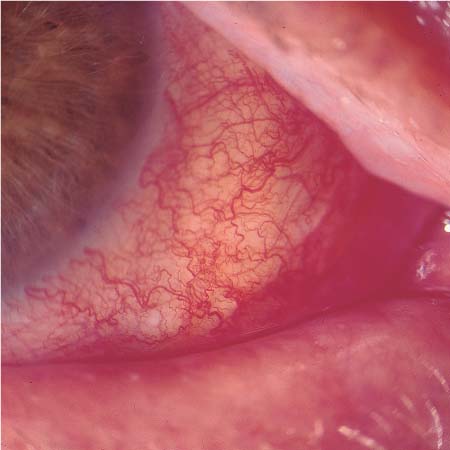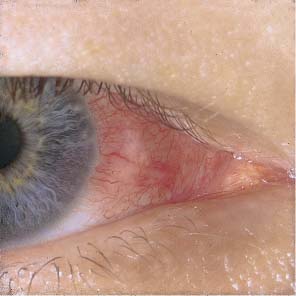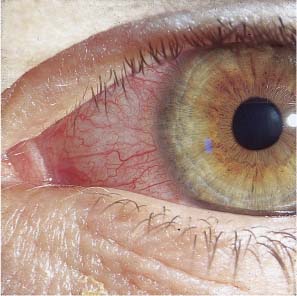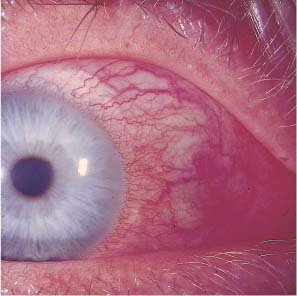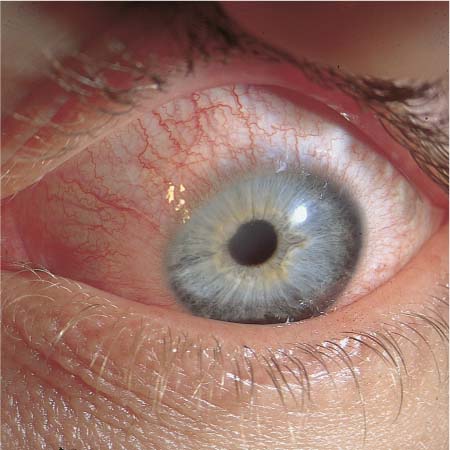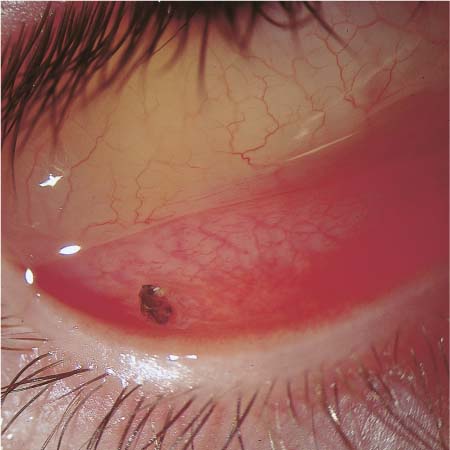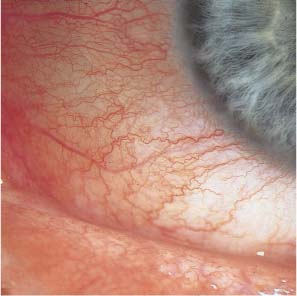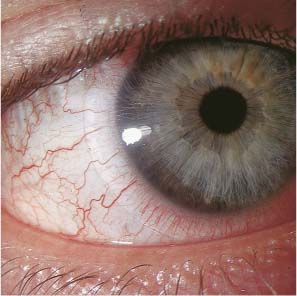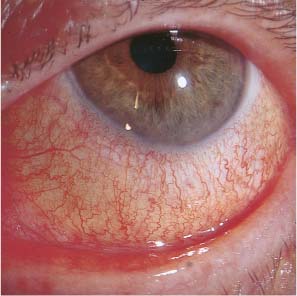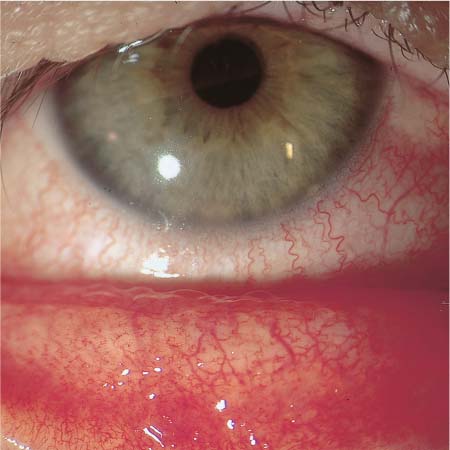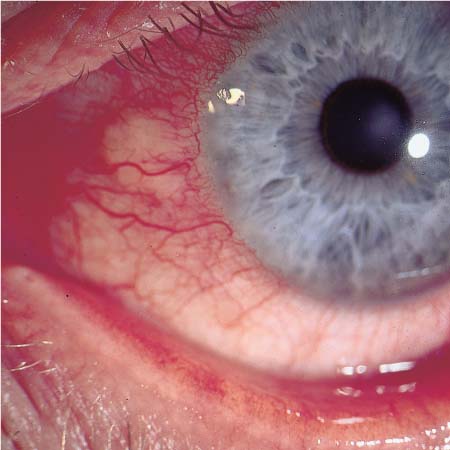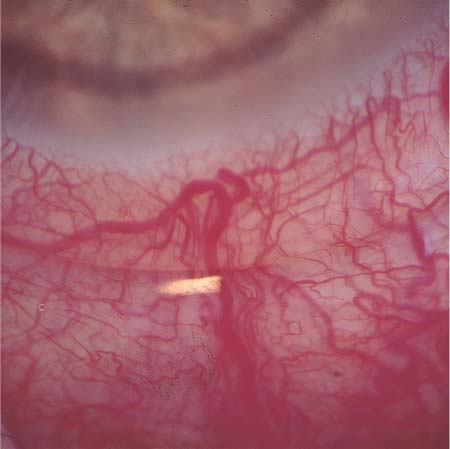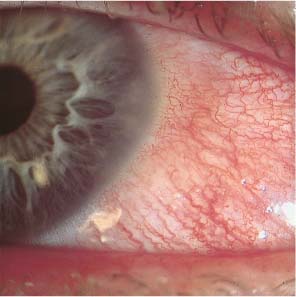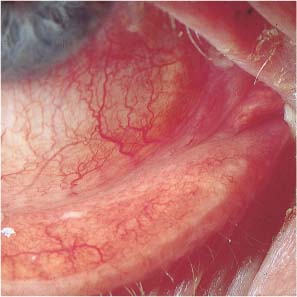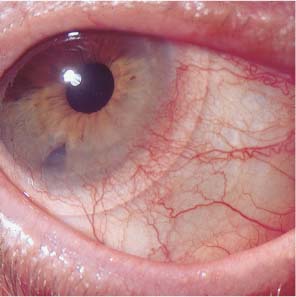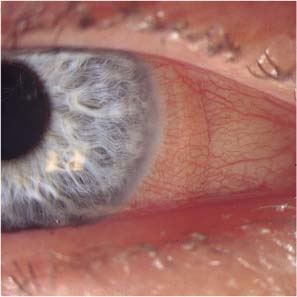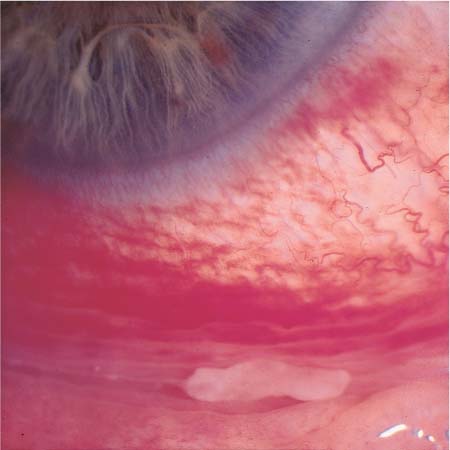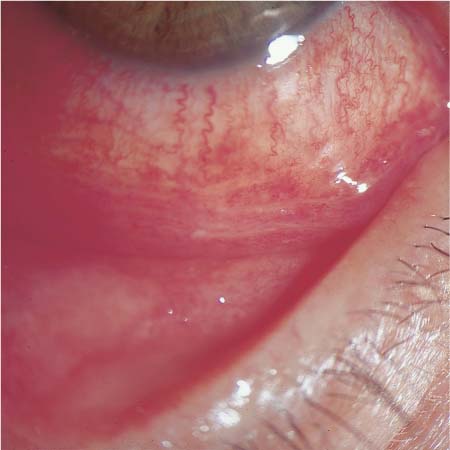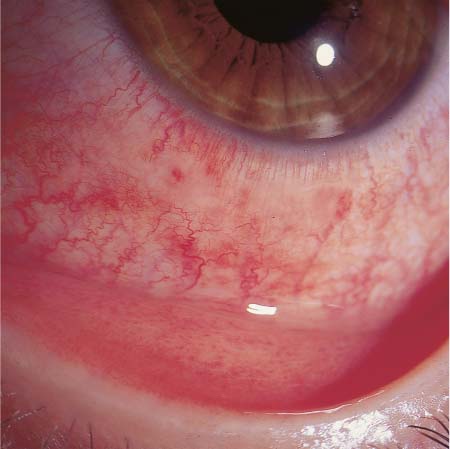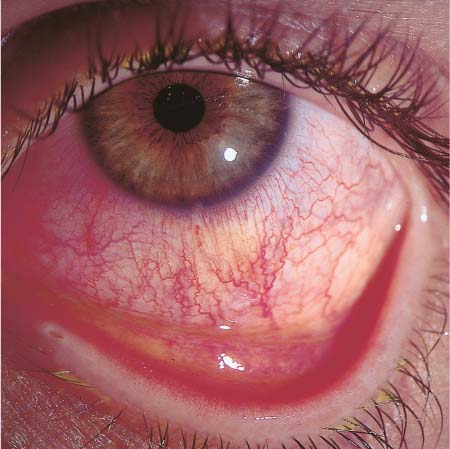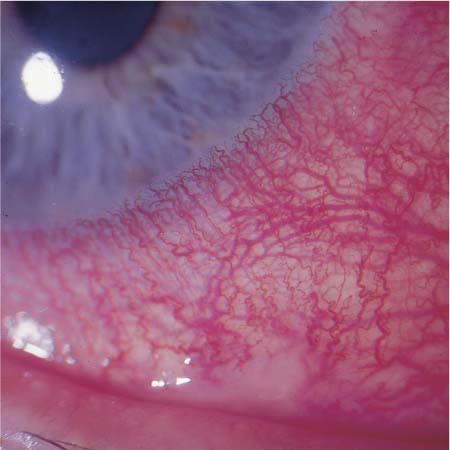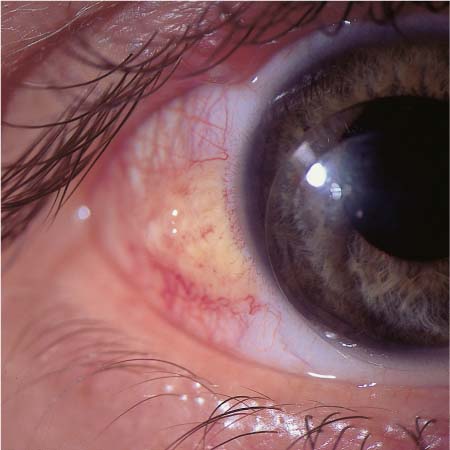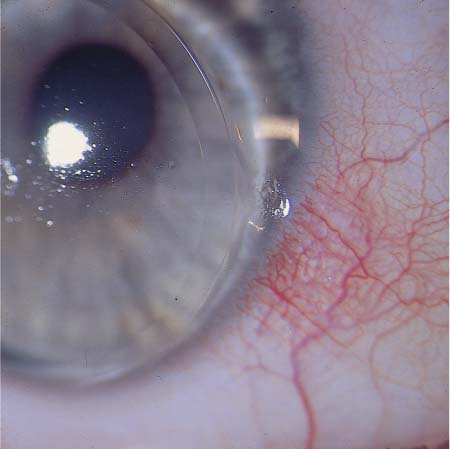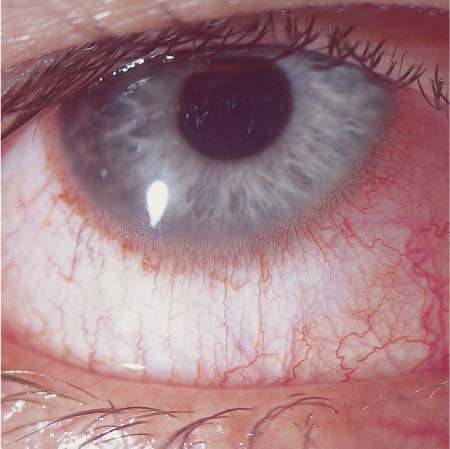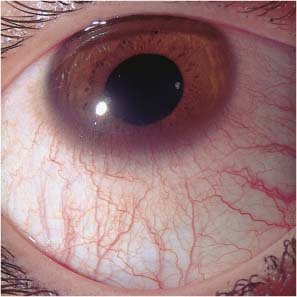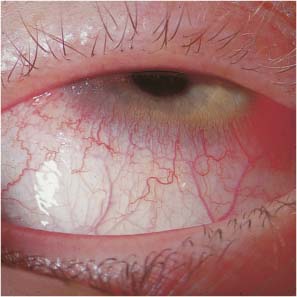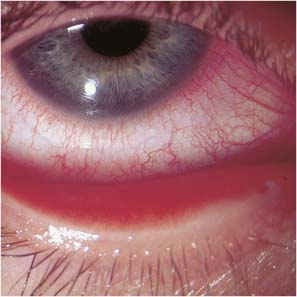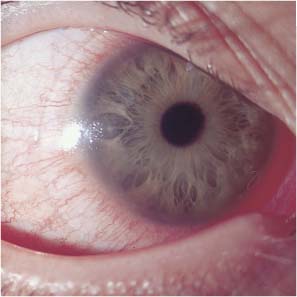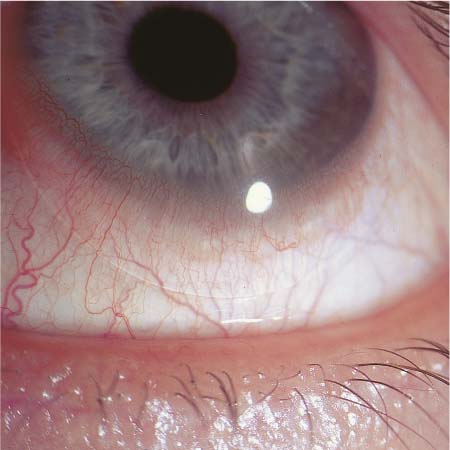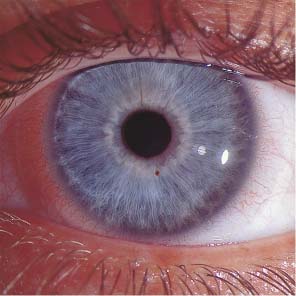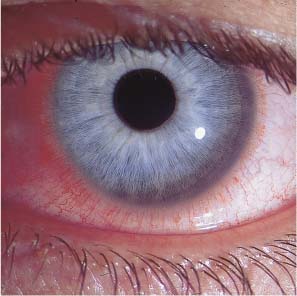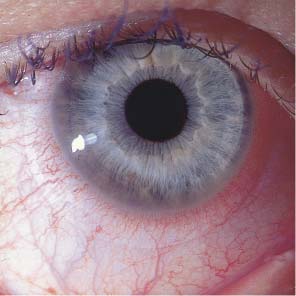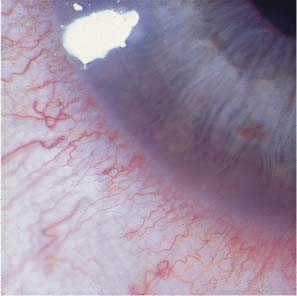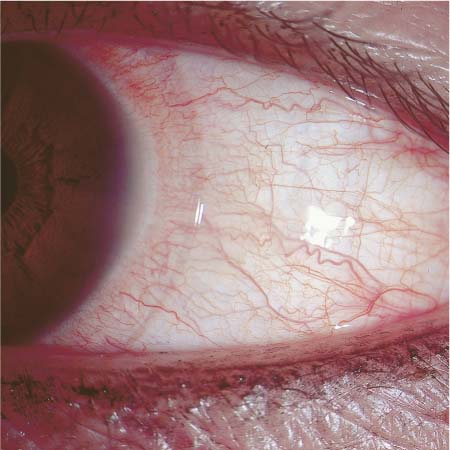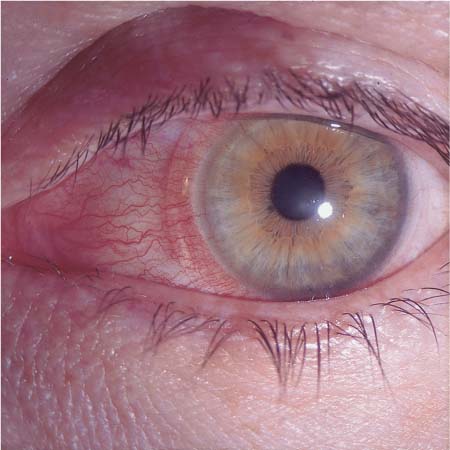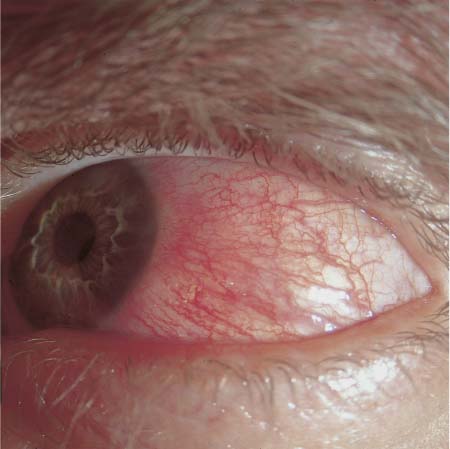3 Pathologic Findings Increased Lid Tension and Blepharospasm Infectious Blepharitis, Squamous Blepharitis, Ulceration Changes of Descemet’s Membrane and the Endothelium Iritis, Uveitis, Panophthalmitis Intraocular Hypertension, Glaucoma Retinal Diseases and Detachment The lids are composed of skin, cartilage, connective tissue, and muscle. The lid muscles not only enable blinking, but also, as a component of the mimetic musculature, communicate the emotional state of the individual. Normal lid function is very important in contactology. With each blink, the surface of the eye is covered with the salt-rich aqueous secretion of the lacrimal glands, and with the fatty secretion of the Meibomian glands that are found at the lid margins. Normal blinking is involuntary and rhythmic when the eyes are adequately wetted, and more frequent when they are dry. Tear flow increases in response to irritation. Chronic excessive tear flow is due to partial or total obstruction of the lacrimal pathway or to an abnormal position of the lid. The most important tasks of the lid are to prevent drying, visual glare, and ocular injury. These tasks depend upon normal lid function, especially in the contact lens wearer. Each blink distributes the tear fluid over the anterior surface of the contact lens and simultaneously slides the contact lens up and down over the cornea, thus enabling exchange of tear fluid in the space between the corneal surface and the posterior surface of the contact lens, the so-called tear lens. Lid closure also cleans the contact lens of any particulate foreign matter deposited on its surface through the tear fluid, or from the ambient environment. The skin of the lid may suffer from any ailment known to dermatology. The most common in contact lens wearers is eczema, which tends to take the form of squamous blepharitis in patients suffering from allergic or ectopic dermatitis. Allergic reactions can be induced both by the lens itself and by the chemicals in lens care products. Symptoms: Uncontrollable bilateral lid contraction. Clinical findings: Lid opening, whether active or passive, is difficult or even impossible. Every contact lens fitter is familiar with the reflex increase in lid pressure and spasmodic lid closure that are often encountered during the initial fitting phase. Failure to improve over time may make the further wearing of contact lenses impossible. These problems are less likely to occur with soft lenses. Blepharospasm with excessive tearing, appearing after a period of unproblematic lens wear, should always be considered abnormal (see Table 8). It is usually caused by acute mechanical irritation of the anterior segment, as by a crack or tear in the lens or by a lesion of the lid margin, conjunctiva, or cornea. Severe inflammation or infection, or a foreign body, can also cause increased lid pressure and blepharospasm. Prophylaxis: Blepharospasm appearing soon after fitting in the sensitive patient can be reduced by having the patient wear the lenses for only a short time each day at first, and then for gradually longer times. Regular lens replacement lessens the frequency of lens defects and thus prevents the mechanical irritation that they cause. Differential diagnosis: Aside from the factors already mentioned, blepharospasm may also be caused by neurological or psychiatric disease. Sometimes it is caused by glare, particularly in children undergoing slit-lamp examination. Note: There is no specific treatment for blepharospasm. If a contact lens is to be removed from a blepharospastic eye, it may be helpful to instill a local anesthetic first. (Caution: gel lenses will absorb the anesthetic agent and must, therefore, be discarded afterward.) Break-in period Excessive lens mobility Defective lens Slipped or inverted lens Irregularities or deposits on the lens surface Dry eye, tear deficiency syndrome Infection or injury of the lids, conjunctiva, or cornea Foreign bodies of any type Psychogenic Symptoms: The upper lid cannot be adequately elevated. Clinical findings: The upper lid overlaps the limbal area of the cornea regardless of the direction of gaze. Severe ptosis may impair vision. Ptosis is usually easy to recognize because of the narrowing of the palpebral fissure, which is most often unilateral, though of variable extent. The diagnosis is made by observing that the midpoint of the upper lid is not contiguous with the upper edge of the pupil, but partially or completely overlaps the pupil when the patient looks straight ahead. If more than half of the pupil is covered, vision will be considerably impaired and treatment will be required, perhaps involving a surgical procedure. Ptosis occasionally occurs as a complication after hard contact lenses are worn for many years. Levator function is impaired by chronic irritation due to the contact lens. This form of ptosis is thus often accompanied by decreased tearing, chronic conjunctivitis, or conjunctival scarring. Scarring is usually seen in the setting of advanced giant papillary conjunctivitis (GPC) and is easy to observe when the lids are ectropionized. Occasionally, supposedly lost contact lenses, or fragments thereof, can burrow into the subtarsal lid tissue and cause a ptosis, appearing months later. Differential diagnosis: Neurological disorders, particularly myasthenia gravis, should be included in the differential diagnosis. Pseudoptosis due to blepharospasm can be tested for by instillation of local anesthetic, which abolishes it. Prophylaxis: Ptosis can be prevented by changing the lenses regularly, and by not wearing them during periods of seasonal allergy. Note: Any ptosis that is not due to contact lenses warrants neurological examination. Symptoms: Swelling of upper and lower lids, discomfort, and fatigue. Clinical findings: Swollen, thickened lids. In contrast to inflammatory or traumatic lid swelling, primary allergic lid edema in contact lens wearers is not accompanied by hyperemia. The upper and lower lids are markedly swollen, and the skin of the lids is devoid of its normal wrinkles. Gentle pressure with a fingertip produces an indentation that lasts for several minutes. Lid edema has both internal and external causes; in contact lens wearers, it is usually caused by allergy to the lens or to lens care products. Artificial tears may soothe the discomfort of lid edema but are often themselves responsible for it. Differential diagnosis: Aside from allergy to the lens and lens care products, lid edema may be caused by cardiovascular disease, renal failure, generalized allergy, and other systemic illnesses, and usually calls for general medical evaluation and treatment. Hyperacute lid swelling (Quincke’s edema) is due to generalized allergy or to poisoning. Prophylaxis: Persons suffering from allergies should not wear contact lenses during critical seasons or in allergen-rich environments. Note: Lid swelling of uncertain cause requires general medical evaluation. Fig. 34 Pseudoptosis due to chronic irritation after many years of wearing moderately well-tolerated hard lenses; an associated finding in a patient with GPC. Fig. 35 Upper lid edema, soft contact lens, allergy to quaternary ammonium bases. Fig. 36 Ectopic dermatitis of the lids; allergy to cobalt, nickel, synthetic materials, mercurial compounds and solutions. Symptoms: Itching of the upper lid, especially the lid margins. Clinical findings: Reddening and swelling of the lid skin; scaling, loss of lashes. Infectious and allergic lid changes are usually seen in combination among contact lens wearers. Infectious blepharitis is usually secondary to a preceding allergic reaction. Squamous blepharitis is classically characterized by reddening, swelling, and scaling of the lid margins. Its causes and course are identical to that of localized eczema occurring elsewhere on the skin. Squamous blepharitis is sometimes restricted to the lid margins, in the spaces between the lashes. The lashes are brittle, poorly developed, or absent, and they may grow in an abnormal direction. More severe blepharitis affects the entire surface of the lids and extends beyond them to the skin of the face. In severe cases, the skin in the region of the inner can-thus is macerated or ulcerated. An allergy is always the cause; in contact lens wearers, the allergy may be to the contact lens, to lens care products, or to artificial tears. Blepharitis is particularly common in immunodeficient contact lens wearers (p. 160). Superinfection is usually due to poor hygiene or an impaired immune response. The responsible organism is usually bacterial, though fungi are particularly common in immunocompromised persons, such as those with diabetes or AIDS. Almost all cases of superinfection are in wearers of soft contact lenses; hard lenses have a negligible absorptive capacity, and the material used to make them is better tolerated. Differential diagnosis: Any other cause of dermatitis may be responsible, as may an allergy to any other substance in the environment, e.g., in cosmetics or environmental toxins. Other possibilities include dermatoses, irritation from a hordeolum or chalazion, basal cell carcinoma, and epithelioma. Prophylaxis: Patients predisposed to blepharitis should not wear contact lenses. Preservative-free lens care products may help reduce its incidence. Note: Recurrent blepharitis requires evaluation by an allergist or dermatologist. Fig. 37 Squamous blepharitis of unknown cause; mild form. Fig. 38 Squamous blepharitis caused by chlorhexidinecontaining lens care solution. Fig. 39 Marked allergic blepharitis; wrinkling of the corner of the lid due to HEMA allergy. Fig. 40 Eczema of the upper lid; allergy to PVP. Fig. 41 Eczema of upper and lower lids; allergy to benzalkonium chloride (BAC) and chlorhexidine. Fig. 42 Matting of the upper lid cilia due to recurrent blepharitis. Fig. 43 Marked upper and lower lid eczema caused by allergy to chlorbutanol, thiomersal, and BAC. Fig. 44 Blepharoconjunctivitis; purulent crusting on the lashes; typical problem caused by bad hygiene. Fig. 45 Bacterial blepharoconjunctivitis with staphylococcal superinfection. Fig. 46 Swelling of upper and lower lids; allergic blepharitis; allergy to thiomersal and BAC; bacterial superinfection. Fig. 47 Marked lower lid dermatitis in gel lens wearer with severe diabetes mellitus; epithelial scaling; superinfection with Candida. Fig. 48 Allergic blepharoconjunctivitis in an aphakic eye; superinfected with Haemophilus; intraocular inflammation. Fig. 49 Ectopic dermatitis; scaling along the lid margin; allergy to cosmetics and contact lens products. Fig. 50 Bacterial blepharitis; conjunctivitis; purulent material seeping through the lashes on the upper lid. Fig. 51 Typical squamous blepharitis with scaly deposits on the lashes; allergy to penicillin and thiomersal. Fig. 52 Bacterial infection of the lid margins; purulent deposits on the lashes; staphylococcal infection in contact lens wearer with AIDS. Fig. 53 Severe blepharitis with loss of lashes; nodular concretions of the lipid-secreting glands on the lid margin, caused by allergy to lens care products. Further testing revealed a nickel allergy (intolerance to piercing). Fig. 54 Ulceration of the lower lid at the inner canthus; severe allergy to multiple preservative agents and lens materials, cobalt allergy, intolerance to piercing. Symptoms: Lid pain. When the lid margin is involved, there is a foreign-body sensation on opening or closing of the lids. Clinical findings: Tissue defect, bleeding. The inner surface of the lid and the tarsal conjunctiva are often injured by the edges of defective lenses. These injuries, though usually superficial, may nevertheless cause permanent scarring that impairs the function of the lid, leading to chronic corneal erosion or recurrent keratitis. Defective soft corneoscleral lenses are particularly likely to injure the sclera or cornea, in addition to the lid. The problem usually arises because the lenses are worn for longer periods than recommended (whether they are of the disposable or brief-wear variety, or are part of a system of exchangeable lenses). The wearing of hard PMMA lenses for many years can also chronically traumatize the tarsal conjunctiva, leaving scars that may make further lens wearing intolerably uncomfortable. Differential diagnosis: Injuries of the types discussed here may be due to foreign bodies other than contact lenses, or to accidents (see p. 186). An adequate history usually reveals the cause. Prophylaxis: Patients should not wear their contact lenses for longer than recommended, and should check them for defects before each insertion. Defective contact lenses do not belong in the eye. Note: Any lid injury should prompt examination for a concomitant injury of the bulb. The conjunctiva reacts promptly to endogenous and exogenous irritants and is thus a sensitive indicator of contact lens complications. Practically any problem caused directly or indirectly by contact lenses is associated with conjunctival changes (though not all conjunctival changes are due to contact lenses). Lid disease caused by contact lenses is associated with changes of the tarsal conjunctiva, and corneal disease caused by contact lenses is associated with changes of the bulbar conjunctiva. Changes of the lids and cornea should be sought whenever a contact lens wearer presents with conjunctivitis, because, in contact lens wearers, the lids, cornea, and conjunctiva constitute a functional unit. The complications that arise are generally due to a disturbance of the physiological, metabolic, and toxicological interrelationship of these three structures. This interrelationship is the central theme of contactological research and accounts for a major part of the ophthalmologist’s work in caring for the contact lens-wearing patient. The conjunctiva is a mucous membrane that extends from the lid margins to the limbal region of the globe. It is a well vascularized, translucent membrane with two portions, tarsal (palpebral) and bulbar. The tarsal conjunctiva is tightly bound to the underlying tissue on the inner surface of the lid, while the bulbar conjunctiva is more loosely applied to the sclera, except in the limbal area. The fornix (zone of transition between the tarsal and bulbar conjunctiva) lies at the most remote area of the surface of the eyeball and forms the base of the conjunctival sac (cul-de-sac). The conjunctiva is a mucous membrane containing many secretory cells; the most important of these for contact lens wearers are the goblet cells. When their function is impaired, lacrimation becomes deficient, the eye dries out, and a foreign body sensation ensues that makes lens-wearing intolerable. Symptoms: Severe itching while wearing lenses; burning; increased secretions; impaired visual acuity (VA). Clinical findings: Hyperemia, follicular swelling; papillary hypertrophy of the tarsal conjunctiva; recurrent deposition of hydrophobic material on lens surfaces. Hyperemia, follicular swelling, and papillary hyper-trophy of the tarsal conjunctiva are the classic signs of GPC in contact lens wearers, a complication that is not at all rare in wearers of hard or soft lenses. This condition is becoming significantly more common, not least because of air pollution. Both in etiology and in phenotype, GPC resembles vernal conjunctivitis (vernal catarrh), a condition seen in the springtime in patients with an allergic predisposition. GPC is caused by proteins from the lacrimal fluid that are presumably denatured by lens-hygiene solutions and thereby become immunologically active. Deposited on the surface of the lens, these proteins act as antigens, to which antibodies then bind. The sandwich of lens, antigen, and antibody rubs on the tarsal conjunctiva, causing increased conjunctival swelling and secretions—the vicious cycle of GPC. The hallmark of GPC is the coating of the contact lens surface with a strongly adherent protein layer, which pierces the film of tear fluid over the lens within seconds of insertion, leading to diminished visual acuity and increased glare. The case history generally points to the diagnosis: The patient wears lenses without complications for weeks or months and then, suddenly, a problem develops. A few minutes after lens insertion the patient experiences burning, chafing, and itching in the eyes. Tears and a film deposited on the surface of the lens impair visual acuity within a few seconds after the eyes are opened, and until the next blink. Conjunctival secretions cause the eyelids to stick together and limit the mobility of the contact lens during blinking and eye movements. Examination reveals the following: the contact lens is barely mobile or immobile on the surface of the eye and is coated with a grayish-white film that makes it look dry and dull. The lids are mildly swollen, and their margins are coated with dried yellowish-white secretion. The bulbar conjunctiva is mildly injected; everting the lids reveals a massive papillary swelling of the tarsal conjunctiva, which is made even more evident with fluorescein staining. GPC can be classified into four stages (Table 9). Fig. 55 Scarring of the tarsal conjunctiva of the lower lid after decades of wearing hard PMMA lenses. Fig. 56 Tarsal conjunctiva 1 hour after test wear of a rigid contact lens for myopia; injection of conjunctival vessels. Fig. 57 Isolated hyperemia of the upper lid conjunctiva caused by protein deposits on the anterior surface of a soft contact lens. Fig. 58 Mild hyperemia of the tarsal conjunctiva; mechanical irritation of the conjunctiva on the initial fitting of a hard lens. Fig. 59 Injection of the upper lid conjunctiva; focal conjunctival atrophy after 18 years of wearing hard lenses for keratoconus; tear deficiency. Fig. 60 Upper-lid hyperemia and edema; allergic reaction to chlorhexidine. Fig. 61 Upper-lid hyperemia; mild cockscomb swelling of the conjunctiva indicating chronic irritation; hard contact lens worn for 6 years. Fig. 62 Early GPC, characterized by hyperemia and moderate papillary hypertrophy; soft hydrophilic lens. Fig. 63 GPC reaction on upper lid; marked hypertrophy of the papillae; hyperemia. Fig. 64 GPC stage 1–2; isolated tarsal conjunctival hyperemia; papillary hypertrophy in the region of the fold. Fig. 65 GPC stage 2–3; papillary hypertrophy; identical picture to vernal conjunctivitis. Fig. 66 GPC in a CAB lens wearer; stage 2; fluorescein staining. Fig. 67 GPC follicular swelling in the region of the lower conjunctival fold; soft contact lens worn for 3 months. Fig. 68 GPC stage 3; fluorescein staining; PMMA lens worn for 11 years. Fig. 69 Marked GPC, stage 3; fluorescein staining; gel contact lens worn for 4 months. Fig. 70 GPC; scarring; 9 months of wearing a fluorosilicone carbonate lens. Differential diagnosis: Other conditions resembling GPC include other allergic reactions of the conjunctiva, auto-immune conditions, and (typically in the springtime) primary vernal conjunctivitis independent of the wearing of contact lenses. Prevention: Meticulous daily lens hygiene, frequent use of protein removers, and a temporary cessation of lens wearing during critical seasons will reduce the risk of GPC. Note: Patients with pollen allergy should be instructed not to wear contact lenses during the hay fever season. Symptoms: Severe itching and tearing; difficulty closing the lids. Clinical findings: Marked swelling of the conjunctiva that may project beyond the lid margin, with clear or sanguineous secretion. Mild proptosis. Conjunctival edema in contact lens wearers is usually due to lens-cleaning solutions, or to wetting solutions or artificial tears that are supposed to enhance wearing comfort. Acute conjunctival edema may occur as early as the fitting phase, particularly when relevant details of the case history are not obtained or disregarded, such as a previous episode of allergic blepharitis or conjunctivitis requiring treatment. Patients with certain types of allergies, for example to thiomersal, a common constituent of eye drops and contact lens solutions, also tend to develop acute conjunctival reactions when contact lenses are fitted. Acute chemosis is a complication that usually appears within a few minutes of the initial insertion of a lens or the initial use of a lens care product or variety of eye drops. Most of the affected patients were previously treated at some time with eye drops or ointments and were presumably sensitized in this way. An adequate history helps to identify and prevent this problem: patients should be asked at the initial prefitting visit whether they have ever had complications from the use of eye drops or ointments, or difficulty tolerating them. If so, the risk is high that the initial insertion of contact lenses will cause marked conjunctival swelling within minutes, so that the fitting will have to be terminated. One can also use the Ophthalmotest to predict adverse reactions in advance and determine the offending solution constituent (cf. p. 80, 86). Ophthalmologists periodically see an emergency case of acute chemosis referred by a contact-lens-fitting optician. The problem typically arises during a fitting session, for example on initial application of a wetting solution to improve lens-wearing comfort. Within a few minutes, massive conjunctival swelling in both eyes may completely occlude the palpebral fissure and make it difficult to close the lids. A retrospectively obtained history usually reveals that the patient has been using non-prescription eye drops irregularly over the years, without medical supervision, to treat hay fever or other allergic symptoms. Acute chemosis can occur even if eyedrops were last used years earlier. Slit-lamp examination in acute chemosis reveals slightly thickened lids with mildly erythematous margins. The bulbar conjunctiva is severely swollen, and there is a large volume of clear or sanguineous secretion. The swelling extends beyond the lid margins, hindering lid closure. Corneal changes are only mild: there may be mild edema, and slit-lamp examination after fluorescein instillation may reveal fine stippling of the epithelium. The anterior chamber is usually normal, and, unless hindered by the swollen lids, vision is normal but for a slight increase in glare. Fig. 71 Acute chemosis 45 seconds after insertion of a soft contact lens stored in Polyquad; known allergy to quaternary ammonium bases. Fig. 72 Acute hemorrhagic chemosis after the application of an artificial tear solution to a dry eye; hard lens; BAC allergy. Fig. 73 Acute bulbar conjunctival injection; immediate reaction to PMMA lens; because of the pressure exerted by the contact lens, the edema is limited to the area not covered by the lens. Fig. 74 Acute bulbar conjunctival injection; immediate reaction to chlorhexidine and thiomersal; the lens contact zone remains visible for a few minutes after the lens is removed. Fig. 75 Jelly-like swelling of the tarsal and bulbar conjunctiva after many years of astringent eye drop abuse while wearing soft contact lenses. Fig. 76 Acute chemosis in a gel lens wearer with known allergies to various plant species, after a brief stay in a garden. Remnants of organic foreign matter in the cul-de-sac, pollen dust on the lens surface. Prophylaxis: Acute chemosis can often be prevented by meticulous history-taking. Note: When acute chemosis occurs, its cause must be determined before the lenses are worn again or new lenses are fitted; otherwise, a recurrence is likely. Symptoms: Usually no pain or discomfort, but patients are highly distressed by the prominently visible abnormality. Clinical findings: Deep-red hematoma under the conjunctiva, which is usually somewhat raised. Multiple microhemorrhagic spots are often present in the conjunctiva of contact lens wearers, usually in the perilimbal region where the lens rests, but occasionally in the tarsal conjunctiva. These easily visible lesions appear spontaneously, often sending the highly distressed patient to the emergency service of the eye clinic. There is usually no pain or impairment of visual acuity. Blood begins to pool under the bulbar conjunctiva shortly after lens insertion, usually arising from a site of injury near the limbus and spreading out evenly under the conjunctiva of the lower half of the eye. When a soft lens is still on the eye, the hematoma in the area covered by the lens is somewhat compressed and thus paler than elsewhere. There is no pain, discomfort, or corneal edema, unless the eyes are rubbed. High-power slit-lamp examination reveals the source of the bleeding as a small tear of the bulbar conjunctiva, rarely more than 1 mm long. Such tears often result from improper lens insertion or removal. Other causes are long fingernails or devices used for lens insertion or removal. Another common cause is a defect of the rim of the lens, for example, a sharp-edged lens tear, breakage, or deposit. Such lesions are usually caused by hard lenses but can also be caused by inadequately rehydrated soft lenses, or by disposable lenses that are worn far beyond the recommended period, until they physically deteriorate. Excessively long wear of disposable lenses regularly produces breaks and tears in the lens, which can injure the lids, conjunctiva, and cornea; similar defects can be produced by improper handling, inadequate hygiene, or storage under excessively dry conditions. The most common causes of subconjunctival hemorrhage are listed in Table 10. To minimize the risk of subconjunctival hemorrhage, the contact lenses should be inspected under a dissecting microscope, or a slit lamp fitted with a contact-lens-holding device, at every follow-up visit. Differential diagnosis: Subconjunctival hemorrhage has a unique appearance and is hardly likely to be confused with any other disorder. It may, however, appear for reasons unrelated to the wearing of contact lenses. Prophylaxis: Patients should be instructed to discard any lenses with visible defects, and to take care not to cut the eye when inserting and removing the lens. Persons with hemorrhagic disorders of any kind should not wear contact lenses. Note: Whenever conjunctival hemorrhage occurs, the contact lenses should be inspected for defects. Patients with recurrent hemorrhages should undergo medical evaluation for a bleeding disorder. A Related to contact lenses Material defects, inadequate polishing, edge defects Improper lens insertion or removal Surface deposits B Not related to contact lenses Mechanical irritation, strong eye-rubbing Vascular sclerosis Coagulopathy, leukemia Iatrogenic (anticoagulation) Tear deficiency syndrome Fig. 77 Hyperacute, severe conjunctival edema; hemorrhagic form; immediate reaction after the initial insertion of a hard contact lens wetted with an artificial tear solution; longstanding abuse of astringent eye drops, known thiomersal allergy. Fig. 78 Perilimbal hemorrhage of the bulbar conjunctiva caused by wearing a soft lens with edge defects. Fig. 79 Conjunctival lesion caused by wearing a disposable soft lens with an edge defect for several months longer than the recommended time. Fig. 80 Figure 79, enlarged; the haptic of the gel lens acts as a tamponade for the hyposphagma. Fig. 81 Extensive bleeding into the conjunctiva at the 6 o’clock position caused by an edge defect of a gel contact lens. Fig. 82 Massive conjunctival bleeding after wearing a hard contact lens with edge defects; 42-year-old patient with coagulopathy. Further wearing of contact lenses is contraindicated. Fig. 83 Cutting injury of the bulbar conjunctiva from a defective lens edge; disposable gel contact lens; prescribed wearing time exceeded. Fig. 84 Cutting injury of the conjunctiva and cornea; 8-year-old soft hydrophilic corneoscleral lens in situ; large, sharp-edged defect. Fig. 85 Perilimbal, superficial conjunctival bleeding caused by improperly processed edge of a PMMA lens. Fig. 86 Conjunctival hemorrhage in the sulcus region; mechanical irritation due to poor fitting. Conjunctival hyperemia in contact lens wearers has a variety of causes, which can often be distinguished from one another by the location and appearance of hyperemia. Focal conjunctival hyperemia is most often due to mechanical irritation of the conjunctiva in a circumscribed area from a dried-out, ill-fitted, defective, or deposit-coated lens; annular perilimbal injection is usually of toxic or allergic etiology. Generalized conjunctival hyperemia (i.e., of the entire conjunctiva, including the area under the contact lens) is usually caused by mechanical irritation or infection; other causes include inadequate lacrimation, allergic or toxic processes, and radiation injury. Whether focal or generalized, the hyperemic area is superficially discolored (brick-red); the reactively dilated vessels of the conjunctiva are always bright red and freely mobile over the scleral surface. (This is not so in cases of conjunctival hyperemia secondary to underlying deep or scleral infection.) Symptoms: Eye-rubbing; foreign body sensation; tearing. Clinical findings: The entire bulbar conjunctiva is injected and appears brick-red. Conjunctival vasodilatation as a rapidly occurring response to a foreign body is routinely observed when a patient first starts to wear contact lenses. Surface vessels of the bulbar conjunctiva are greatly enlarged during this period. This response is normal in the initial phase of contact lens wear, but pathological at later times. The causes of mechanical irritation of the conjunctiva in contact lens wearers are listed in Table 11. If a lens is fitted too flatly, its edge does not lie securely on the limbus and can rub against the conjunctiva. Lens cracks, fractures, or polishing defects, as well as surface deposits due to inadequate cleaning are other causes of mechanical irritation. Injury of the conjunctiva from an exogenous foreign body looks much the same as injury from a contact lens; the two situations may be difficult to distinguish. It may be useful to remove the lens and examine the conjunctiva with fluorescein or rose bengal staining; distinctive traces of the foreign body may become evident. Material defects, inadequate polishing Flat fitting, decentration Surface deposits Lesion of the lid margin Lesion of the cornea Tear deficiency syndrome A common cause of generalized conjunctival hyperemia in contact lens wearers is inadequate lacrimation. Any qualitative or quantitative, primary or secondary impairment of lacrimation impairs the ability of the lens to glide without friction over the cornea and conjunctiva. The unlubricated lens acts as a foreign body and causes mechanical conjunctivitis. The symptoms include burning, foreign body sensation, rubbing of the eye, and epiphora. Defects in the conjunctival and corneal epithelium can be detected with rose bengal. Symptoms: Burning; eye-rubbing; foreign body sensation; epiphora. Clinical findings: Injection and chemosis of the entire conjunctiva; secretions. Conjunctivitis with generalized injection is certainly the most common complication of contact lens wearing. The symptoms include burning, foreign body sensation, eye-rubbing, and epiphora. Symptoms: Burning; eye-rubbing; foreign body sensation; tearing. Clinical findings: Generalized injection and chemosis; secretions in the cul-de-sac. Fig. 87 Severe conjunctival hemorrhage after a punch in the eye; the gel lens remained intact. Fig. 88 Conjunctival hyperemia; mechanical irritation from a hard contact lens characterized by an even, brick-red discoloration of the entire bulbar conjunctiva. Fig. 89 Focal lateral bulbar conjunctival hyperemia from a foreign body reaction; hard contact lens; typical brick-red color. Fig. 90 Focal lateral conjunctival hyperemia from a foreign body reaction; rigid contact lens. Fig. 91 Focal limbal conjunctival hyperemia from a foreign body reaction; gel contact lens. Fig. 92 Focal conjunctival hyperemia with accentuation near the limbus, due to a foreign body reaction; soft contact lens. Fig. 93 Diffuse conjunctival injection from a foreign body reaction to a rigid contact lens; tear deficiency. Fig. 94 Severe conjunctival swelling; erythema from a foreign body reaction in a patient wearing gel contact lenses. Eversion of the lower lid reveals an insect wing as the cause. Fig. 95 Diffuse conjunctival injection as a foreign body reaction to a hard contact lens worn for many hours. Fig. 96 Diffuse conjunctival irritation after test wear of a gel contact lens for 4 hours; tear deficiency. Fig. 97 Mild, diffuse conjunctival hyperemia; tear deficiency; gel contact lens with desiccated anterior surface. Fig. 98 Marked, deep-red conjunctival discoloration due to both superficial and deep vasodilatation; mechanical irritation; soft, hydrophilic contact lenses. Fig. 99 Marked, diffuse brick-red coloration of the conjunctiva in bacterial conjunctivitis. Fig. 100 Bacterial conjunctivitis due to Haemophilus in a patient wearing gel contact lenses. Fig. 101 Massive conjunctival injection, mildly accentuated in the area contacted by the (soft, hydrophilic) contact lens; bacterial conjunctivitis due to Pseudomonas. Altered ocular flora Epithelial defects Faulty lens cleaning Faulty lens disinfection Tear deficiency Elevated temperature of the corneal surface Impaired immune competence Chronic hypoxia Overwearing Wearing deteriorated lenses Systemic infection Wearing lenses during sleep Parasitic infection Infectious conjunctivitis is among the more common conditions treated by the ophthalmologist, affecting both contact lens wearers and the general population. Improper lens wear (Table 12) predisposes to its occurrence; it is caused by a broad spectrum of micro-organisms—bacteria, viruses, and occasionally fungi or Acanthamoeba. The characteristic signs of bacterial conjunctivitis are swelling of the lids and generalized injection of the bulbar and tarsal conjunctivae. The cul-de-sac contains copious mucous or proteinaceous secretions. As long as the infection is limited to the conjunctiva, the cornea is clear and visual acuity is unaffected; the anterior chamber is normal. Excessive tearing may affect vision. If the interior of the eye is inflamed, changes in the refractive media may impair visual acuity, but this is rare. Culture of the secretions in the cul-de-sac may reveal the etiologic organism; Pseudomonas, Staphylococcus, Haemophilus, and Pneumococcus commonly cause conjunctivitis in contact lens wearers (Table 13). Bacterial conjunctivitis is often the result of inadequate lens hygiene. The biofilm in the lens case provides an excellent breeding ground for bacteria and fungi; soft, hydrophilic lenses are more commonly the vector of infection than hard lenses because their aqueous portion can act as a culture medium for microorganisms. Adenovirus Herpes simplex virus Pneumococcus Aspergillus Haemophilus Pseudomonas Candida Klebsiella Staphylococcus Chlamydia Moraxella In patients with infectious conjunctivitis, samples for culture should be obtained not only from the cul-de-sac, but also from the surfaces of the contact lenses, and from the lens case, for identification of the organism and determination of its pattern of antibiotic sensitivity and resistance. The latter is particularly important, not only for the choice of the best antibiotic, but also for assessment of the efficacy of the various contact lens hygiene systems currently available on the market. Differential diagnosis: Bacterial conjunctivitis is a clinically distinctive entity. It should not be forgotten, however, that conjunctivitis can be caused by foreign bodies of various kinds in the cul-de-sac, including “lost” contact lenses or lens fragments. Recurrent conjunctivitis may be due to an immunodeficient state, a metabolic disorder, or repeated reinfection from the throat, nose, skin, or ear (transfer of organisms by way of the pillow). Prophylaxis: Two basic steps will minimize the risk of conjunctival inflammation: first do careful lens hygiene, second stop all lens wearing during an infection. Note: Bacterial conjunctivitis in contact lens wearers is almost always due to poor lens hygiene. If lens-wearing is not discontinued, corneal infection may ensue. Fig. 102 Bacterial conjunctivitis; gel contact lens; diffuse conjunctival hyperemia without accentuation in the area contacted by the lens. Fig. 103 Bacterial conjunctivitis; soft contact lens; streptococcal infection. Fig. 104 Toxic hyperemia, most severe in the perilimbal area; thiomersal reaction; standard aphakic fitting. Fig. 105 Mechanical hyperemia; perilimbal white ring of compression from steeply fitted lens; tear deficiency. Fig. 106 Bacterial conjunctivitis; pus in the lower cul-de-sac; staphylococcal infection. Fig. 107 Diffuse conjunctival infection and hemorrhage; viral conjunctivitis; hard contact lens. Fig. 108 Viral conjunctivitis; diffuse brick-red to deep-red discoloration of the conjunctiva, with hemorrhage; soft contact lens wearer. Fig. 109 Fungal conjunctivitis; diffuse vasodilatation with mild paralimbal accentuation; soft contact lens; candidiasis in a diabetic patient. Symptoms: Burning; itching; foreign body sensation; tearing. Clinical findings: Marked injection; microhemorrhages; swelling of the plicae; minimal secretion. Unlike bacterial conjunctivitis, viral conjunctivitis is rarely related to contact lens wearing; it is usually a manifestation of systemic viral infection, for example influenza. Nonetheless, though primary viral conjunctivitis is the most common type, fitters of contact lenses must be aware that poor hygiene on their part may cause an outbreak of iatrogenic epidemic keratoconjunctivitis (EKC). Differential diagnosis: Viral conjunctivitis is distinguished from bacterial conjunctivitis by the watery secretion in the cul-de-sac, and by the swollen plicae (particularly in EKC). Signs of infection often involve the cornea as well. Cases that fail to improve with treatment should arouse suspicion of another type of infection, such as fungal or parasitic. Foreign body reactions as well as toxic and allergic processes must be excluded. Note: Viral conjunctivitis is highly contagious. The patient’s family and acquaintances are at risk, as are the personnel and patients of the lens-fitting practice. Symptoms: Foreign body sensation; eye-rubbing; sensation of heat and dryness. Clinical findings: Marked surface injection accompanied by marked, generally livid, deep injection; whitish secretions in the cul-de-sac. Fungal infection is rare in healthy contact lens wearers and is usually seen in those suffering from immune compromise, diabetes, or other metabolic disorders. Candida albicans and Aspergillus niger are often the cause. Fungal infections are difficult to treat. Corneal involvement or infiltration into the interior of the globe poses a major threat to vision. Fungal infections are much more common in soft lens wearers than in hard lens wearers, as the soft lens is an ideal fungal culture medium. The organisms take the water they need from the aqueous compartment of the lens, and nutrients and electrolytes from the lacrimal fluid. Fungal infections are best diagnosed by microbial culture of the secretions from the cul-de-sac. Microscopic examination of secretions and of the contact lens itself may reveal fungal hyphae. Demonstration of the responsible fungal organism serves to exclude other possible causes of conjunctivitis, for example GPC. Differential diagnosis: Fungal infections of the anterior segment are not always readily distinguishable from bacterial or viral infections, particularly because mixed flora may be present. Microbial culture is required. Prophylaxis: In general, patients at risk of fungal infection should not wear contact lenses. Those who do wear lenses must comply rigidly with the recommended lens-care routine. Note: The diagnosis of a fungal infection in a contact lens wearer should prompt medical evaluation for latent or active diabetes or an immunocompromised state. Focal conjunctival hyperemia is due to a spatially restricted process; thus, in contact lens wearers, it is usually found in the limbal area, (i.e., at the periphery of the contact lens). The etiology of hyperemia in contact lens wearers (as in other persons) may be toxic, allergic, metabolic, mechanical, or inflammatory. Symptoms: Increased foreign body sensation; increased tear flow. Clinical findings: Marked dilatation of the vessels at the 3-o’clock and 9-o’clock positions. These sites are often covered with a mildly raised, yellowish deposit. Conjunctival injection near the limbus at the 3-o’clock and 9-o’clock positions in a hard lens wearer implies an inadequate cushion of tear fluid between the lens and the eye. The lens mechanically irritates the conjunctiva and cornea during horizontal saccades. The problem may be caused by inadequate lacrimation or by poor fitting. Diagnostic assessment includes quantitative tear analysis, inspection of the sit of the lens, and slit-lamp examination of the cornea after staining. Differential diagnosis: Conjunctival injection near the limbus can also result from local lesions of the conjunctiva and cornea. Note: Check for corneal defects in all cases of localized conjunctival injection. Fig. 110 Marked deep-red discoloration of the conjunctiva due to candidiasis in a soft contact lens wearer with AIDS. Fig. 111 Marked conjunctival vasodilatation at the 3-and 9-o’clock positions in a hyperopic wearer of hard contact lenses with tear deficiency. Fig. 112 Focal conjunctival hyperemia at the 4-to 5-o’clock position; injury of the edge of the cornea through improper fitting. Fig. 113 Isolated perilimbal conjunctival hyperemia under a hard corneoscleral contact lens. Mechanical irritation by excessively tight fitting in the haptic zone. Symptoms: The discomfort is rarely severe and is usually limited to itching and a feeling of dryness. Clinical findings: Markedly dilated vessels in the paralimbal or perilimbal region. Isolated, superficial perilimbal injection is a pathological finding seen almost exclusively in wearers of soft contact lenses. It is easily mistaken for ciliary injection, which indicates an intraocular process. The affected vessels in ciliary injection are livid in color, more deeply situated, and more finely reticulated. An arc-shaped, superficial perilimbal area of injection (sometimes accompanied by fine microhemorrhages) is usually due to faulty lens fitting. If the edge of the lens is too steep or too firmly applied to the conjunctival surface, it can compress the bulbar conjunctiva in the region of the corneal sulcus. On the other hand, if the lens is too flat, its edges can scrape the perilimbal conjunctiva. The differential diagnosis is straightforward: If the perilimbal redness disappears within 10 minutes of lens removal, the lens was too flat; if in the same period of time a reactive hyperemia appears, the lens was too steep. Redness from wearing lenses with abrasive edges or edge defects disappears within 1–2 hours after the lenses are removed. Hyperemia of this type is only rarely associated with corneal injury. Deep perilimbal vasodilatation indicates an entirely different situation. Deep-red or livid vessels, located below the surface and parallel to the limbus, are a definite indication of corneal damage or an intraocular process. The usual cause in contact lens wearers is toxic keratopathy in reaction either to the lens material or to a lens care product. A finding of deep and livid (rather than superficial and brick-red) vasodilatation limited to the limbal region is classically termed “ciliary injection.” The dilated vessels are located in the perilimbal sclera and are an indication of deep corneal and intraocular changes, such as iritis or uveitis, which are very rarely related to the wearing of contact lenses. It may prove difficult to determine by examination whether the finding is superficial (perilimbal) or deep (ciliary), particularly in protracted cases. A rule of thumb for the crucial differentiation of primary intraocular problems from contact lens complications is that the latter, unlike the former, generally resolve after the lenses are removed. Color Location Cause Brick-red Conjunctival surface Mechanical irritation, fitting error Bluish-red Superficial and deep conjunctiva Toxic, allergic reaction Livid blue Deep conjunctiva, sclera Intraocular complication, iritis, iridocyclitis, uveitis It is not always easy to classify limbal hyperemia or to determine whether it is due to the wearing of contact lenses. A thorough history and a meticulous slit-lamp examination of the limbus under highest power are mandatory. The most important criteria for differential diagnosis are listed in Table 14. The Ophthalmotest is an excellent aid to the examination of conjunctival changes, especially perilimbal reactions, and enables differentiation of improper lens fitting from a toxic or allergic reaction (pp. 80, 86). Differential diagnosis: In summary, perilimbal and limbal injection must be distinguished from scleral and intraocular processes, which cause deep perilimbal (particularly ciliary) vasodilatation and thereby produce a livid (bluish-purple)—rather than brick-red—perilimbal ring. Prophylaxis: Immediate ophthalmological examination in the early phase of perilimbal injection can prevent further injury. Note: Intraocular disease must be ruled out whenever perilimbal vasodilatation is found. Fig. 114 Focal conjunctival hyperemia at the limbus; hard contact lens; tear deficiency. Fig. 115 Marked, diffuse conjunctival hyperemia; tear deficiency; soft contact lens; marked drying of the anterior surface of the lens. Fig. 116 Diffuse vasodilatation of the bulbar conjunctiva with accentuation at the limbus; dry eye; gel contact lens. Fig. 117 Diffuse bulbar conjunctival vasodilatation with accentuation at the limbus at the area of contact of the soft contact lens; deposits on the lens surface; tear deficiency. Fig. 118 Brick-red perilimbal injection from poorly seated soft contact lens; hyperopia + 6.5 D. Fig. 119 Limbal hyperemia; diffuse bulbar conjunctival vasodilatation due to a toxic keratopathy; gel lenses; PMMA intolerance. Fig. 120 Limbal injection in toxic keratopathy; hyperemia of the bulbar and tarsal conjunctiva. Soft hydrophilic contact lens. Fig. 121 Firered limbal hyperemia in toxic keratopathy; reaction to lens cleaning agents; gel contact lens. Fig. 122 Enlargement of Figure 121. Fig. 123 Toxic conjunctival hyperemia, especially marked at the limbus, caused by PMMA allergy. Fig. 124 Perilimbal hyperemia from toxic damage to the conjunctiva and cornea; thiomersal allergy; soft contact lens. Fig. 125 Pseudoepiscleritic irritation after several weeks of wearing a defective contact lens. The sclera, the stabilizing outer layer of the eye, is almost entirely composed of strong, interwoven, opaque collagen fibers; at the limbus, it makes a seamless transition to the transparent cornea. The sclera is completely shielded from the outside world by the conjunctiva. It is only loosely bound to the inner layer of the conjunctiva and to Tenon’s capsule, with enough slack to ensure that saccadic eye movements in any direction are not hindered. Isolated pathological changes of the sclera are only rarely the result of wearing contact lenses. Symptoms: As in conjunctival inflammation: itching, foreign body sensation; rarely tearing; a sensation of pressure on the globe. Clinical findings: Scleral vessels are a deep, livid color; concomitant conjunctival injection. Pseudoepiscleritis can be caused by the haptic of hard or soft corneoscleral lenses rubbing against the surface of the eyeball, or by the wearing of lenses with defective edges. Vasodilatation indicates mechanical irritation or infection of the sclera; scleral infection is usually secondary to conjunctivitis or keratitis. The deep-seated, livid discoloration that typifies these scleral changes is clearly distinct from the intense, brick-red color of the overlying conjunctiva and its vessels. Note: Intraocular disease must be ruled out whenever scleral inflammation is found.
Lid
Anatomy and Physiology
Increased Lid Tension and Blepharospasm
Ptosis
Lid Swelling and Edema
Infectious Blepharitis, Squamous Blepharitis, Ulceration
Lid Injury
Conjunctiva
Anatomy and Physiology
Tarsal Conjunctiva
Follicular Swelling, Papillary Hypertrophy, Giant Papillary Conjunctivitis
Bulbar Conjunctiva
Conjunctival Edema and Acute Chemosis
Subconjunctival Hemorrhage
Generalized Conjunctival Hyperemia
Mechanical Irritation and Injury
Infection
1. Bacterial Conjunctivitis
2. Viral Conjunctivitis
3. Fungal Infection
Focal Conjunctival Hyperemia
3-O’Clock and 9-O’Clock Limbal Hyperemia
Perilimbal and Limbal Injection
Sclera
Anatomy and Physiology
Pathology
Vasodilatation and Inflammation
![]()
Stay updated, free articles. Join our Telegram channel

Full access? Get Clinical Tree


Ento Key
Fastest Otolaryngology & Ophthalmology Insight Engine

